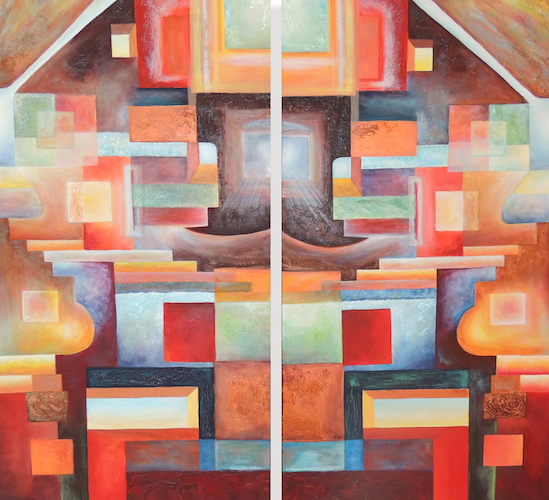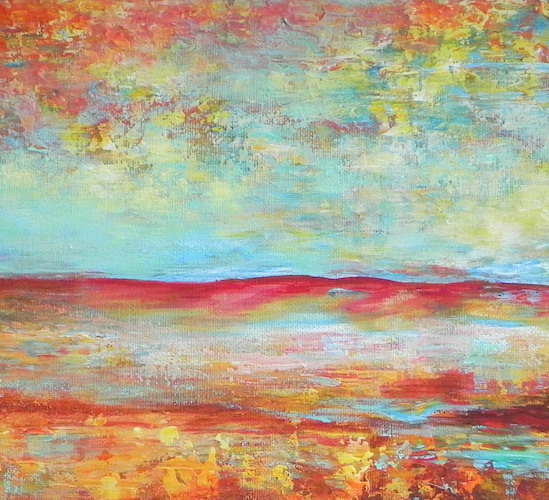Artist Manifesto 1
I am intrigued by how the mystery, beauty, and magic of art can captivate the viewer so that they are able to escape to a more uplifting place. My paintings are reflections of other worlds that I have visited in past lives, in dreams, and within myself. The colours are chosen to resonate with subconscious emotional and spiritual meaning. As a psychic, past life reader and energy healer, my paintings serve to heal others by showing a window into the higher dimensions that I see. The positive energy I transfer into my paintings will continue to uplift and energize the viewer long after I am gone.
Temple Series Manifesto
When I began the first ‘Temple’ painting, I felt stuck in the drudgery of life and I was seeking greater meaning and spiritual release. The result was the creation of a profound world of illusionistic depth and surreal landscapes. Viewers gain access to portals that transport them to elevating dimensions. The symbolism in my paintings, such as images of doorways, stairs, tunnels [2], cups [3], and the heart [4], directly impact the viewer’s subconscious so that they easily understand the paintings’ meaning. It is important to me that my art is accessible to all and not just to the educated art world. The mirror images signify the two halves of all organisms. Each human body is split in two sides that are the same yet slightly different. In the pursuit of wholeness the masculine and feminine halves seek to join together in love [5]. The diptych [6] and triptych [7] paintings represent both the unity and the separation of our selves and our environments. Vibrant colours correspond to chakra [8] colours in order to open and charge the chakra energy centres in the body. Viewers receive healing, inspiration, and a sense of spiritual awakening when in the presence of these paintings.
Link to Temple Series


Artistic Process & Mediums
Painting is a moving meditation whereby I manifest my visions. Creating allows me to experience the connection to my spirit and to channel divine energy. I am inspired by nature, light and by the human experience of beauty, desire and magic. I like to play with colour, texture, and depth to create subtle moods and mystical worlds. I employ a variety of media including acrylic paint, acrylic mediums, collage, found objects, oil pastel, drawing media and oil paint. My early explorations in art began with collage, drawing, and sewing and led to painting and mixed media. At the Emily Carr University of Art & Design I studied video, vocal performance, sound design, fine art, sculpture, and multi-media installation. I completed my degree in Integrated Media Arts. Multi-media art ignited my interest in phenomenology 9 and the sensorial aspects of human understanding. These explorations influenced my paintings to take on greater conceptual depth in order to better describe the complexity of our experiences.
Footnotes
1. An art manifesto is a public declaration of the intentions, motives, or views of an artist or artistic movement. In this case it is the main artist statement for all of my paintings series.
2. The doorways, stairs and tunnels represent ways to travel from one space to another, in this case to move to higher spiritual planes.
3. The cups symbolize the Holy Grail, the cup that is said to have been used by Jesus Christ and that was sought by knights during the Middle Ages. It represents the spiritual heights and profound goals that we seek out in our life’s journey. The suit of cups in the tarot represents the emotional fulfillment, love, and close relationships that we seek. “My Cup Runneth Over” is a quotation from the Hebrew Bible (Psalm 23:5) and it represents the abundance that is provided to us through God’s generosity and love. The overflowing cup also represents Jesus and so it refers to resurrection and eternal life. In my work as an artist and healer I paint this cup to express and share in the eternal abundance that resides within all of our hearts.
4. The heart is often depicted in two halves in order to represent the separation we sometimes feel in our hearts when we long for another to share in our love. In some paintings the heart contains cracks and pieces to show how the heart can endure many breaks. Yet when healing the heart can still build new parts and this is where I have painted new windows within it.
5. When I speak of masculine and feminine these are terms that describe the different energies within each of us rather than any specific gender. We all contain both masculine and feminine energies within us and we seek to love all aspects of ourselves in order to feel more complete and healed. Our search of a partner or ‘other half’ sometimes helps to balance our personalities and to bring a sense of companionship and fullness to our lives.
6. A diptych in this case is a set of two paintings that are hung together to create one art piece.
7. A triptych in this case is a set of three paintings that are hung together to create one art piece.
8. The chakra, meaning ‘wheel’ or ‘circle’ is a center of subtle body believed to be psychic-energy centers in the esoteric traditions of Indian religions. They are believed to be part of the subtle body, not the physical body, and connected by energy channels called Nadi.[i] In the Kundalini version of yoga, breath exercises focus, in part, on mastering and channeling energy through Chakras.[ii]
9. phenomenology is a) the study of the development of human consciousness and self-awareness as a preface to or a part of philosophy b) a philosophical movement that describes the formal structure of the objects of awareness and of awareness itself in abstraction from any claims concerning existence c) the typological classification of a class of phenomena such as the phenomenology of religion d) an analysis produced by phenomenological investigation e) phenomenology attempts to create conditions for the objective study of topics usually regarded as subjective: consciousness and the content of conscious experiences such as judgements, perceptions, and emotions. Although phenomenology seeks to be scientific, it does not attempt to study consciousness from the perspective of clinical psychology or neurology. Instead, it seeks through systematic reflection to determine the essential properties and structures of experience.[iii]



